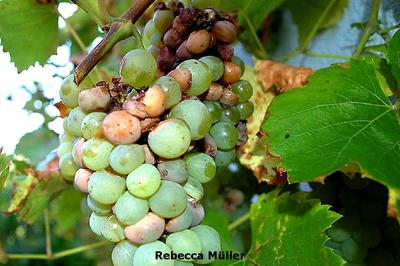Grape Bud Moth
Eupoecilia ambiguella
ପୋକ
ସଂକ୍ଷେପରେ
- Larvae feed on buds and berries, causing considerable damage.
- Buds or berries are webbed together by silk threads.
- Presence of gray or brown mold on feeding sites.
ମଧ୍ୟ ଦେଖା ଯାଇପାରେ
ଲକ୍ଷଣ
Young larvae drill into the flower buds and feed internally, resulting in damage that makes the grapes unmarketable. During this first feeding period, they connect several buds together with silk threads, eventually forming a thick webbed shelter where they develop. The second generation of caterpillars cause more trouble since they feed on the berries growing around their shelter, leaving abundant frass. A single larva can feed on up to a dozen berries and thus may cause considerable damage. The injury is worsened by the secondary infection of the feeding sites by the gray mold, Botrytis cinerea. Adjacent berries, otherwise undamaged, may also become colonized and become brown and moldy. This moth is considered a very serious pest in many wine-producing areas in Europe and Asia.
ସୁପାରିଶ ଗୁଡିକ

ଜୈବିକ ନିୟନ୍ତ୍ରଣ
Parasitic wasps like Trichogramma cacoecia and T. evanescens lay eggs into the eggs of this pest and can therefore significantly reduce grape bud moth infestations in vineyards. Make sure not to diminish the population of these natural enemies by the excessive use of broad-scale insecticides. Effective organic insecticides against E. ambiguella include products based on Spinosad and natural pyrethrin. The number of spray applications depends on the amount of infested berries.

ରାସାୟନିକ ନିୟନ୍ତ୍ରଣ
Always consider an integrated approach with preventive measures together with biological treatments if available. Effective insecticides against E. ambiguella include pyrethroids. Where it is a recurrent problem, a post bloom insecticide application may be necessary, and a late summer application may be needed to control the second generation. The number of spray applications depends on the amount of infested berries. Temperature and humidity are the decisive factors to determine the emerge of the second generation of caterpillars.
ଏହାର କାରଣ କଣ
The symptoms are caused by the feeding activity of the caterpillars of the grape bud moth Eupoecilia ambiguella and the colonization of the damaged tissues by the fungus Botrytis cinerea. The adult moth has yellow-brown forewings, with a conspicuous dark brown band and gray, fringed hindwings. Females deposit eggs (up to 100 per female) singly on flower buds or bracts during late spring or on grape berries during mid summer. The larvae hatch after 8-12 days. They are brownish-yellow and up to 12 mm in length, with scattered hairs over the whole body. Overwintering occurs as a second generation pupa in cracks on the bark or other suitable places. The life cycle of the moth is highly dependent on temperature and humidity. It is usually found in cooler and humid areas, and has only two generations per year. The optimum relative humidity level for development is 70% or higher and temperature between 18 and 25°C. Eggs will fail to hatch at low relative humidity levels and temperatures.
ସୁରକ୍ଷାତ୍ମକ ଉପାୟ
- Check for quarantine regulations in your country and contact competent authorities in case of doubt.
- Regularly monitor the grapevines for infested buds or berries.
- Use pheromone traps to assess numbers.
- Since the moth overwinters as pupae in leaf litter on the ground, remove and destroy grapevine debris to reduce emergence in spring.
- Alternatively, covering leaf litter with compacted soil will prevent emergence.
- Both of these options must be completed three weeks prior to bloom.
- In light infestations, remove injured berries by hand.
- Do not transport potentially infected material to other fields or farms.



